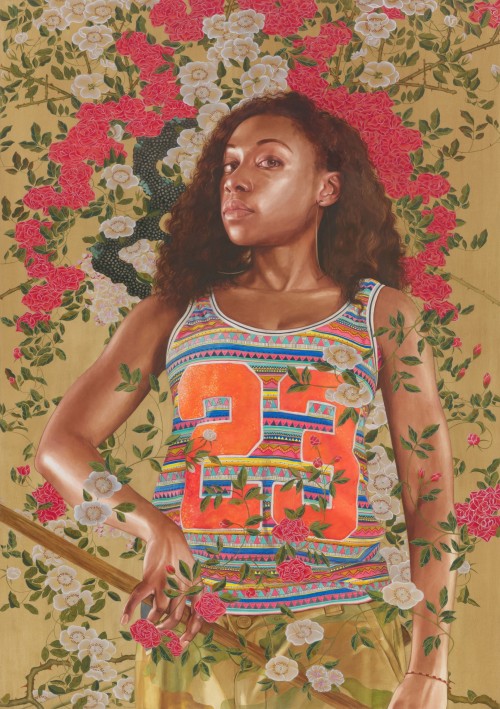
Kehinde Wiley: Colorful Realm
Roberts Projects is delighted to announce Colorful Realm, an exhibition of new work from renowned contemporary artist Kehinde Wiley. Drawing inspiration from Japanese nature paintings of the Edo period (c.1600–1868), Wiley parallels traditional techniques and materials in nine monumental paintings. Exposed linen highlights the depicted natural scenes while also preserving the delicate balance of the untouched picture space. Per the artist, “So much of my work is about appearance and showing up and being visible, and this dance between exploring the vastness of space within the minimality of this technique I find to be an interesting juxtaposition.”
In this new work, Wiley references famed Edo-period artists such as Kitagawa Utamaro, Kiyohara Yukinobu, and Utagawa Kunisada in his use of negative space in compositions that significantly advance his distinct visual lexicon. In the absence of something besides a single subject, the functional emptiness highlights the oneness of nature and the expansive scale of the natural world. The impact of these ideas echoes throughout. The focal point of each painting is the story itself, one that extends beyond a path that blends into the horizon, and the understanding of the narrative as a whole. Similarly, Itō Jakuchū’s renowned Images of the Colorful Realm of Living Beings (c. 1757-1766), from which this exhibition takes its title, embodies how nature scenery is depicted and symbolized in Japanese art.
Panoramic displays of flora and fauna—both real and fantastical—are rendered in meticulous detail on raw silk in rich compositions that blur the boundary between painting and objects of devotion. Jakuchū's virtuosity in capturing these details is noteworthy, as it provided considerable insight into the then-contemporary understanding of the relationship between nature and art.
Wiley broadens the political context of the divine subject, as admired by an Edo audience, by exploring painting’s role in communicating power, ritual, and performativity, and how this dialogue can shift historical memory by both incorporating and monumentalizing Black and brown men and women in art historical spaces not accustomed to their presence.
The mid-Edo period saw the rapid growth of an urban culture, due in part to the movement of artists between rural to inner-city locales, and an expansion of both literary and artistic practices, including painting, woodblock prints, ceramics, lacquer, and textiles. This period also saw the growing influence of different cultural markers, specifically Chinese and Western art, newly reflected within Japanese aesthetic principles. In Wiley’s reinterpretation of the Edo period’s visual vocabulary, the overlapping relationships are decidedly more global. Per Wiley, “This series has developed over a number of years and has involved models from different stages of my life. You'll find models from New York, West Africa, and Europe. This exhibition is an opportunity to picture some of my favorite subjects within one body of work.”
With this new series, Wiley recontextualizes the naturalist landscape genre from a non-Western perspective, activating different historical memories and therefore different ways of thinking about man's relationship to nature. Generally removed from any narrative content, he re-presents the landscape as one with intersecting cultural, social, and artistic discourses. The aesthetic principles of his practice–portraits defined by their dramatic realism set against dynamic backgrounds–have expanded to incorporate a heightened appreciation for the natural world. The rigidly structured English William Morris style, as featured in Wiley’s celebrated series The Yellow Wallpaper (2020), has given way to a more organic aesthetic expression. The overall effect, in its looseness and beguiling simplicity, is more subtle, more sensitive yet more complex when seen as a whole.
Kehinde Wiley (b. 1977, Los Angeles) is an American artist best known for his portraits that render people of color in the traditional settings of Old Master paintings. Wiley’s work brings art history face-to-face with contemporary culture, using the visual rhetoric of the heroic, the powerful, the majestic and the sublime to celebrate Black and brown people the artist has met throughout the world. Working in the mediums of painting, sculpture, and video, Wiley’s portraits challenge and reorient art-historical narratives, awakening complex issues that many would prefer to remain muted.